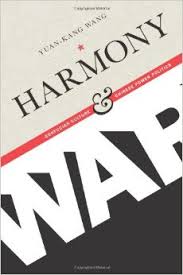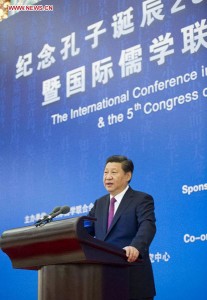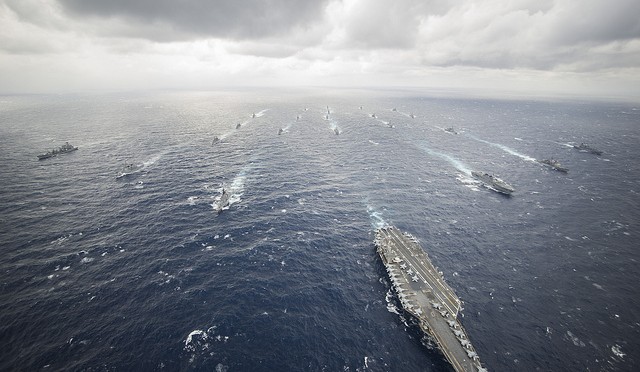John J. Mearsheimer concludes his book, The Tragedy of Great Power Politics, with the chapter “Can China Rise Peacefully?” This is certainly on the minds of many, as over the the past few years the size of China’s economy has overtaken that of the U.S. While China’s economy grows, so too has her aggressive stance on her territorial claims in the South China Sea, Scarborough Shoal and the Senkaku Islands. Coupled with her rapid double digit increases in military spending, one would be hard pressed not to conclude that China is quickly rising to “Great Power” status, if not there already.
At the same time, China’s leadership has gone out of its way to promote its policy of “peaceful development.” It has embarked on a program of “neighborhood diplomacy” emphasizing “friendship and partnership” and “good neighborliness.” It has even enshrined this policy of peaceful development and eschewed hegemonic intentions in the Chinese Communist Party doctrine.
 China asserts that unlike Western powers, it can rise peacefully due to its unique Confucian cultural tradition. In 2014, China celebrated the 2,565th birthday of Confucius (551-479 BC), and President Xi Jinping provided the keynote address marking the occasion. In it, he sought to emphasize that China’s Confucian heritage, integrated within Communist doctrine (naturally) would promote social harmony at home and peaceful understanding with its neighbors and the world. Martin Jacques, author of When China Rules the World, suggests as much when he describes China as a “civilization state” rather than a “nation state.“
China asserts that unlike Western powers, it can rise peacefully due to its unique Confucian cultural tradition. In 2014, China celebrated the 2,565th birthday of Confucius (551-479 BC), and President Xi Jinping provided the keynote address marking the occasion. In it, he sought to emphasize that China’s Confucian heritage, integrated within Communist doctrine (naturally) would promote social harmony at home and peaceful understanding with its neighbors and the world. Martin Jacques, author of When China Rules the World, suggests as much when he describes China as a “civilization state” rather than a “nation state.“
So what are we to make of this? Will China’s “Confucian exceptionalism” exempt her from the traditional historical patterns of conflict when rising powers bump up against status quo powers like the United States? Yuan-kang Wang, assistant professor at Western Michigan University addresses that question in his book, Harmony and War: Confucian Culture and Chinese Power Politics. In it, he asks, “To what extent does culture influence a state’s use of military force against external security threats?” This is the central concern to those in the world outside of China, as history tends to suggest that when a rapidly rising power threatens an established power, competition almost inevitably leads to conflict – the dreadful Thucydides’s Trap. (There is a good argument that the trap may already have been sprung.)
 Returning to China and its Confucian tradition, what does history suggest? The premise of Dr. Wang’s book is to address head on whether “cultural theories [which] argue that ideational factors … can transform the harmful effects of [state system anarchy] and have an independent effect of state behavior.” Therefore, China’s strategic behavior in the past should largely reflect and be explained by the cultural traditional of “Confucian pacifism.”
Returning to China and its Confucian tradition, what does history suggest? The premise of Dr. Wang’s book is to address head on whether “cultural theories [which] argue that ideational factors … can transform the harmful effects of [state system anarchy] and have an independent effect of state behavior.” Therefore, China’s strategic behavior in the past should largely reflect and be explained by the cultural traditional of “Confucian pacifism.”
Confucian pacifism has four key features: a culture of antimilitarism, defensive grand strategy, the theory of just war and limited war aims. Antimilitarism suggests that China has a historic bias toward civil virtue over martial virtue as shown by its state promotion of Confucian ideology. Its tradition of nonviolence led it to favor a defensive grand strategy over aggressive expansion, relying on “cultural attraction” or the “benevolent way” as opposed to the Western tradition of the “hegemonic way.”
Even Confucius understood that military preparedness was important to state survival. However, he argued for “righteous war” (similar to Western just war), and suggested that force be used “only when defensive options are exhausted.” Confucius also maintained that force is justified “when the ruler of another state is morally depraved,” similar to the current theory of “humanitarian intervention.” Yet this should be punitive in nature, and not for the purpose of annexing territory or expansion. War aims should be limited to the restoration of the status quo ante, never for the total destruction of the enemy.
So does Chinese history bear out its Confucian pacifism? Dr. Wang looks at two periods in China’s history, the Northern and Southern Song Dynasty (960-1179 AD) and the Ming Dynasty (1368 – 1644 AD) and finds that “Confucian culture did not constrain the leaders’ decision to use force; in making such decision, leaders have been mainly motivated by their assessment of the balance of power between China and its adversary.” This largely aligns with the expectations of structural realism theory as opposed to cultural realism theory.
Dr. Wang argues that three themes emerge in Chinese history. First, “China’s decision makers frequently probed for weakness in the country’s adversaries and took advantage of it when found.” Imperial China was never reluctant to use force, nor did it use force only as a last resort. China is not as pacifist as some scholars (and its political leadership) would suggest.
Second, its use of coercive force largely correlated with its relative power position. When strong, Imperial China adopted “offensive-oriented” strategies. When it considered itself weaker, they sought to maintain a defensive posture and be more accommodating “while embarking on domestic reforms aimed at strengthening its military forces and improving its economy.” Indeed, court documents and transcripts indicate that officials would most often refer to Sun Tzu’s strategy of subduing the enemy without fighting only when in a position of weakness rather than as a matter of universal policy.
Finally, war aims were not limited to “defensive border protection” or “restoration of the status quo.” This was evident in both policy debates within the Imperial Court and in actual behavior. Indeed when China had to adopt a more defensive posture, this was less a cultural preference and more a result of insufficient offensive capabilities.
 Take China’s construction of The Great Wall. This is often pointed to as an example of both Confucian pacifism and China’s historically defensive nature. However, Dr. Wang’s review of court transcripts on the decision making process and historical context that led to its construction paint a different picture. Construction of the today’s recognizable wall began in 1474 AD, during the Ming Dynasty, amid constant conflict with the Mongols. Debate amongst the Ming court showed a preference for launching an attack on the Mongols to recover lost territory and bring them to heel. However, they were constrained not by a cultural predilection for defensive strategy but rather a lack of offensive capabilities. Indeed, the Confucian traditionalists “lamented that a country as great as China should come under the mercy of the culturally inferior nomads” – themes that would be echoed by Chinese leadership today when recalling China’s “Century of Humiliation.” In short, an assessment of military weakness drove the Ming to build The Great Wall, not Confucian tradition.
Take China’s construction of The Great Wall. This is often pointed to as an example of both Confucian pacifism and China’s historically defensive nature. However, Dr. Wang’s review of court transcripts on the decision making process and historical context that led to its construction paint a different picture. Construction of the today’s recognizable wall began in 1474 AD, during the Ming Dynasty, amid constant conflict with the Mongols. Debate amongst the Ming court showed a preference for launching an attack on the Mongols to recover lost territory and bring them to heel. However, they were constrained not by a cultural predilection for defensive strategy but rather a lack of offensive capabilities. Indeed, the Confucian traditionalists “lamented that a country as great as China should come under the mercy of the culturally inferior nomads” – themes that would be echoed by Chinese leadership today when recalling China’s “Century of Humiliation.” In short, an assessment of military weakness drove the Ming to build The Great Wall, not Confucian tradition.

Dr. Wang’s historical study challenges the popular narrative of China’s historic cultural pacifism. This has implications for future relations between China, her neighbors and the United States, as China’s leaders use this Confucian tradition as a legitimizing mechanism of its peaceful development and growing military power. He ends his study by suggesting that “based on theory and history, China will gradually shift to an offensive grand strategy when it has accumulated sufficient power.”
Of course, one should not be fatalistic or succumb to historical determinism. Conflict need not be inevitable. However, while history does not repeat itself, it does rhyme. American policy makers (and our friends and allies around the world) would do well to consult Dr. Wang’s book.
About the Author:
LT Robert “Jake” Bebber USN is an Information Warfare officer assigned to U.S. Cyber Command and is a contributor to the CIMSEC NextWar Blog. His articles have appeared in Orbis, Proceedings, Small Wars Journal and elsewhere. Jake holds a PhD in Public Policy from the University of Central Florida. He is supported by his wife, Dana and their son, Vincent. The views expressed here are his own and do not reflect those of the U.S. Department of Defense, the U.S. Navy or U.S. Cyber Command. He welcomes your comments at jbebber@gmail.com.





 Heard of Guadalcanal? Check. But what about the rest of the South Pacific? Between 1999 and 2012, Australia committed troops to multiple peacekeeping and stabilisation missions in Timor Leste, the Solomon Islands and Bougainville. In this podcast, get to know the neighbours–Australia’s neighbours. Listen to Natalie Sambhi interview ASPI analyst and resident silver fox,
Heard of Guadalcanal? Check. But what about the rest of the South Pacific? Between 1999 and 2012, Australia committed troops to multiple peacekeeping and stabilisation missions in Timor Leste, the Solomon Islands and Bougainville. In this podcast, get to know the neighbours–Australia’s neighbours. Listen to Natalie Sambhi interview ASPI analyst and resident silver fox, 
